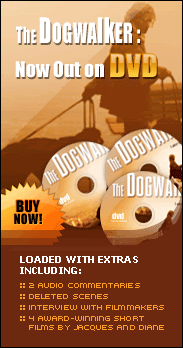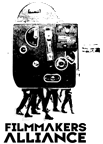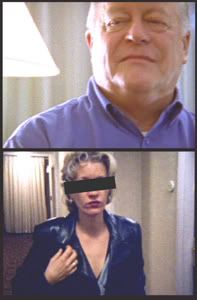1. DON’T BE AFRAID TO ASK
You can’t be afraid to ask, and you need to find the right time to ask. The balance of those two things is crucial. When you think you’re in a place where a potential investor or donor believes in your project and believes in you, then you shouldn’t be afraid to ask them [for] what it is you need. [On Kickstarter,] you can reach out to friends, family, to whatever networks you have, and hit them all at once with a well articulated, honest and humble pitch. We’ve put together nicely laid together print packages. I don’t know how many people really read those. I don’t think you can go in there as a salesman. I’ve never had anyone invest based on reading the literature we’ve created. They invest or donate because they connect to you as an artist, whether you make that connection over coffee or if you make it over the Internet.
— Matthew Porterfield, Putty Hill
In Matthew Porterfield’s Putty Hill, a feature film that recently received a four-star review from Roger Ebert, a young man’s death in Baltimore unites a fractured family and their community. Visit puttyhillmovie.com for updates.
2. GIVE YOUR PITCH A HOOK
When someone tells me to check out a project, the first thing I do is click on the video. It’s really important to craft a teaser or video to hook people right away, because that’s what people are going to judge you by. Nelson (Dellaggiore, Chess Movie: The Story of I.S. 318’s editor) did that right from the get go. It pulls you in, with music and titles, and makes you want to watch more. Know that the audience is going to be people — in our case — that like chess [or] that don’t like chess, that are film people who understand the creative stuff and people that don’t. You’re going to have to make a video that appeals to all of those people. We were thinking mainstream: “What’s the widest audience?”
— Katie Dellamaggiore, Chess Movie: The Story of I.S. 318
And, our biggest successes, surprisingly, were from the chess world. It spoke to them even though we didn’t focus on any of the things that they would care about!
— Nelson Dellamaggiore, Chess Movie: The Story of I.S. 318
Katie and Nelson Dellamaggiore’s Chess Movie: The Story of I.S. 318, The Best Jr. High Chess Team in the Country tells the amazing story of a Brooklyn middle school with the best chess team in the country and not much else. Follow the film’s progress at rescuedmedia.com.
3. HAVE A GOAL AND EXPRESS IT
I already had an end goal. I already had distribution. I knew I was going to make something and there was going to be a final outlet for it. I think that was to my advantage. I was pitching (the Ethiopian music festival the Festival of 1,000 Stars) to several people and I heard a response from [Sublime Frequencies] — I’ve been watching the films they’ve put out for years and listening to their music. I sent them a couple of my films in the proposal and they wrote back and said that they would distribute if I went and made it. So then there was the problem of finding enough money to get [to Ethiopia]…
— Olivia Wyatt, Staring into the Sun
Olivia Wyatt’s Staring into the Sun explores the images and landscapes of 13 Ethiopian tribes in this visually stunning film. The trailer is a must-watch. Watch it here, and find out more about the film’s distribution label, Sublime Frequencies, at sublimefrequencies.com.
4. REACH OUT TO COMMUNITIES
For me, it’s been about the overlapping communities. I get a lot of people to donate because they know about the band (Dark Dark Dark). I get a lot of people who donate because they’re fans of street art. And, other people have found out about it through film-related areas. For me, it’s been figuring out those communities and how to reach out to them — whether it’s through email, Facebook, word-of-mouth or announcing it at [shows]. And I think sometimes those communities can be unexpected. It would’ve been easy to overlook people who are into street art — Why are they going to care about this film about a river? — or people who are into the band. It’s [about] taking a look at your project and thinking about the different ways in which people can connect to that project and why those people will care about it. It’s about being as resourceful as you can and funding helps — it’s really important — but I think the most important thing is finding and working with a supportive community of people.
— Todd Chandler, Flood Tide
Todd Chandler’s Flood Tide is a road movie on a river. It tells the story of four musicians who create extraordinary boats out of ordinary junk and set out for open water. You can help Todd and his crew complete the film by donating at Kickstarter. And, for more information, visit Flood Tide’s official site and theFlood Tide fan page on Facebook.
5. EMBRACE SOCIAL NETWORKING SITES
Promote and network yourself as much as possible! That was the key [for us]. We got social networking accounts — like every account. On MySpace, we reached out to local musicians to collaborate with our project. Once they were interested, we also had the opportunity to promote the project to their fans as well. So, it was a quick way to get the word around, by not only promoting yourself but working with other people, getting to know other people. It helps get the word around faster.
— Rhodrick Magsino, Little Brass Bird
Elliott Bambrough, Rhodrick Magsino and Robin Poppert’s Little Brass Bird is a stop-motion show that’s been rewarding donors by creating plush toy likenesses for upcoming episodes. Visit their official site at littlebrassbird.com for more on the show.
6. SLOW AND STEADY WINS THE FUNDING RACE
You have to have a plan of action. You can’t just put it out there and expect that it’s going to happen. Since [The Battle of Brooklyn] was about an issue that affected a lot of people in New York, we recognized five or ten lists or groups that might be interested. Instead of hitting them all at once, we tried to parse it out so we’d get a bump every couple of days, so that wouldn’t just lay fallow. It needs to have a certain kind of momentum. I’ve invited a couple of other people to [start Kickstarter projects] and they both failed. They didn’t plan. They reached out to everybody on the first day — so maybe they’d get to 20 percent of their goal in first couple of days. But then, it just stopped there. It’s like if you were going to run a marathon and you were going to run the first mile in 4 1/2 minutes, and then 13-minute miles the rest of the way. They used up all of their resources instead of trying to build it [over time].
— Michael Galinksy, The Battle of Brooklyn
David Beilinson, Suki Hawley and Michael Galinsky’s The Battle of Brooklyn is a documentary about the use of eminent domain and the fight between real estate developers and residents over the Atlantic Yards, the largest development project in Brooklyn’s history. Read more of Galinsky’s tips for Kickstarter projects at the International Documentary Association and followThe Battle of Brooklyn at http://rumur.com/battle.
7. KEEP IN TOUCH WITH YOUR FUNDERS
The constant contact is really key. Especially in this day and age, it’s about building and cultivating an audience for yourself so you can hopefully sustain [your film career]. I was talking to someone recently who had contributed to both of my campaigns. She had also contributed to a number of others. She said, “You’re the only one that I really found this connection with.” There are a couple [of other campaigns where] she’s never heard from the people — she was assured that she would at some point. It’s hard because it varies by your own personality, how you connect with people. I do think there’s a real value, when people are giving you money, even if you know their name and address — you have an obligation to be in contact with them and let them know what’s going on. They were excited about the project in the first place! If you do really put an effort into the contact, over time, it will pay off, in terms of being able to get your work out there and sustain your work.
— Gregory Bayne, Jens Pulver: Driven
Gregory Bayne’s Jens Pulver: Driven is a documentary about a champion UFC fighter and his last match. Its Kickstarter project was a smashing success, raising more than $25,000 in just 20 days. For more about Jens Pulver: Driven, head over to thislovelymachine.com.
8. MAKE YOUR PITCH PERSONAL
It seemed to be really helpful to give as much of a personal story as possible to why I wanted to make the film, instead of talking about the kind of software I would use or more technical things that most people don’t care about. And that’s a trap that I fall into when I try to explain what excites me about animation. I end up getting technical and jargony. Try to make it a personal story about yourself as a filmmaker as much as you can!
— Vance Reeser, Beast of Black Lake
Vance Reeser’s Beast of Black Lake was an early Kickstarter favorite, an animated short about a man haunted by a vision he once saw in a mysterious lake. Get updates and continue supporting the film atbeastofblacklake.tumblr.com/.
9. TELL PEOPLE WHAT’S UNIQUE ABOUT YOUR PROJECT
Let yourself and your uniqueness shine through. There might be tendency to appeal to the widest demographic possible, but I think, on the contrary, you should embrace your uniqueness and try to embrace whatever’s unique about you or about [your] project. I think that’s why people are getting excited. In the normal Hollywood system — even in the normal indie funding system — these films would be impossible [to fund]. A lot of these films are trying different things, they’re taking risks. When I see projects that are expressing that, and expressing this level of uniqueness, I can respond.
— Matthew Lessner, The Woods
Matthew Lessner’s The Woods is a feature film about a group of kids who’s attempted utopia in an Oregon forest turns into Lord of the Flies. It’s one of the earliest Kickstarter film projects. Lessner’s personal homepage is montelomax.com.
10. USE WHO YOU’VE GOT
In [my] first Kickstarter campaign, I was really excited to launch it, and it was going well, but I ended up not getting it funded. I was about $3,000 shy of my $5,000 goal. In the process of putting it out there and testing the waters, I was able to refine language, better understand what I was really providing with this project: What was the voice I was offering? But also, How does it connect with people? and, How will they experience the end product? I felt resolve, even though it wasn’t funded, to take those lessons and do a little bit of digging in — and relaunch the campaign. I spent a couple of months connecting with the people that stepped forward during the first campaign. I wrote letters and called them, and I asked them, What was their impression? and, What did they hope to get out of seeing [the project] fulfilled? And then I relaunched [the project] two months ago, and as of two days ago, we reached our $1,000 goal. The lesson I learned was, as in all fundraising, it’s more about how we’re engaging in a conversation with our key constituents and the people that we want to connect the work to. Are they finding value in it? Is it valuable to them?
— Karl Cronin, Somatic Natural History Archive
Karl Cronin documents his dance-derived imitations of various — and eventually every — endangered U.S. plant and animal species in the (now renamed) The Dancing Ecologist. Visit his Kickstarter page or find out more about his work at naturalhistory.us.















Thank you for sharing this Jacques. I often think about the psychology of the funding members in these situations and what they stand to gain from the experience. This blog post is great becuase it outlines ways to add value to the relationship so it's not simply just transactional.
ReplyDeleteGreat blog by the way. I've been a reader for a while but this is my first time commenting.
excellent tips! will use it for my kickstarter campaign. thanks so much!
ReplyDeleteGreat blog!
ReplyDeleteMake sure you also use the best film & tv production guide out there @ locationlockdown.com
Made for the indie filmmaker.
Check it out.
Great blog, I especially like the make it personal part. You're not only raising funds for your project but you're asking them to believe in you. Great stuff!
ReplyDeleteVery nice tips you share. My friend is in film industry i will share this link with him, it is very helpful for him.
ReplyDelete